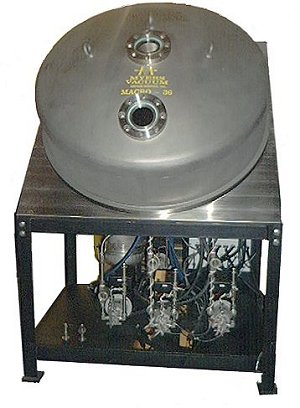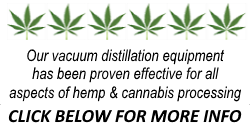 To achieve effective separation, or purity of distillate, careful attention must be given to feed rates; otherwise there will not be uniform evaporation at the heated evaporator surface – i.e., the film layer closest to the heaters will be subject to greater thermal hazard, while the successively remote film layers will receive proportionately diminished energy gain because of laminar flow.
To achieve effective separation, or purity of distillate, careful attention must be given to feed rates; otherwise there will not be uniform evaporation at the heated evaporator surface – i.e., the film layer closest to the heaters will be subject to greater thermal hazard, while the successively remote film layers will receive proportionately diminished energy gain because of laminar flow.
The inhibiting presence of un-stripped, low boiling volatiles and moisture will produce an extremely high gas load in the still chamber and pumping system, resulting in either lower feed rates or elevated operating temperatures required by the higher pressures in the evaporator. Consequently, the importance of adequate degassing equipment and properly sized pumping systems must not be overlooked.
As a general rule, the effectiveness of the separation is contingent upon the differential in molecular weights of the feed mixture. However, the higher the molecular weight differential, the sharper is the separation cut.
When the molecular weights of the mixture components are below 400, there is a tendency towards a broad overlap of adjacent carbon numbers in the resulting distillate. There is a set of optimum operating conditions of temperature, pressure, and feed rate to be balanced in each individual distillation.
Here is a typical composition before and after molecular distillation. percentage composition of raw material is monoglyceride-42%, free glycerine-3%, color (APHA) is 300-700%, acid value 2%.
Purity of distillate is as follows: monoglyceride-over 92%, free glycerine-Less than1%, color is Less than 60%, acid value is Less that 1%. Product yield is over 35%.(see table below)
Separation of Monoglycerides
| MATERIAL | PERCENTAGE OF FEED STOCK | PURITY OF DISTILLATE |
|---|---|---|
| monoglyceride | 42% | over 92% |
| free glycerine | 3% | below 1% |
| color (APHA) | 300-700% | below 60% |
| acid value | 2% | below 1% |
| product yield over 35% | product yield over 35% | product yield over 35% |
However, better controlled formulation of the feed mixture can result in a much purer distillate. This was evidenced when the following material was distilled at 20 X 10-3 Torr: total monoglycerides-60-80%, diglycerides-33.21%, triglycerides-5.03%, glycerine-0.62%, free fatty acids-0.14%. Melting point was 60ºC. Operating conditions were as follows: pressure-20 X 10-3 Torr, temperature-160ºC, feed temperature-80ºC. Purity of the resulting distillate was as follows: monoglycerides-over 95%, diglycerides-4.42%, triglycerides-0.22%, glycerine-0.08%, free fatty acids-0.28%. Product Yield was over 50%.(see table below)
Material Distilled at 20 X 10-3 Torr
| MATERIAL | PERCENTAGE OF FEED STOCK | PURITY OF DISTILLATE |
|---|---|---|
| total monoglycerides | 60-80% | over 95% |
| diglycerides | 33.21% | 4.42% |
| triglycerides | 5.03% | 0.22% |
| glycerine | 0.62% | 0.08% |
| free fatty acids | 0.14% | 0.28% |
| product yield over 50% | product yield over 50% | product yield over 50% |
Typical production rates for the monoglyceride example cited above are approximately 1900 pounds per hour feed rate with a corresponding 950 of distilled monoester on a MAGNA 60.

